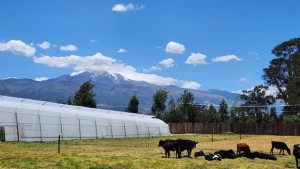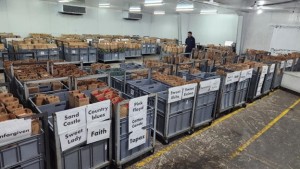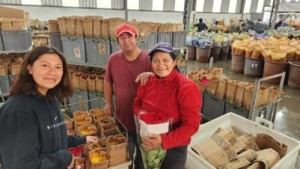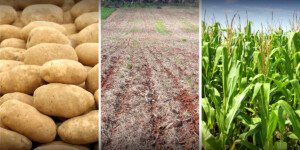Centuries before Saint Valentine was marrying couples in ancient Rome, legend says the red rose sprouted from the ground, watered by Aphrodite’s tears and her lover Adonis’ blood. Throughout the ages, the quintessential red rose has been a symbol of love, but have you wondered where it comes from? Most rose production is centralized in four key countries situated along the equator: Ecuador and Colombia in Latin America, and Kenya and Ethiopia in Africa.
My first introduction to rose production began in Ecuador, where the Andean highlands create ideal growing conditions with a favorable climate at high altitudes. In this region, the Andean mountains stand against the horizon, with the hilltops covered in flower-producing greenhouses. This is where Valentine’s Day is the most important production season, generating 40%-80% of a grower’s annual revenue, with Mother’s Day coming in second.
As much time as I have spent choosing the right romantic message and picking the perfect flowers, considerably more time, planning, and preparation have gone into growing and delivering those flowers. The journey of a rose is just as intricate and beautiful as the love and meaning we want it to convey to our loved ones.


Roses take about 75 days to grow, which means that October begins the demanding production cycle. Mature plants are pruned to stimulate new shoots, which results in new flowers that can all be harvested at the same time in January. Just like all the attention and care you give your loved ones, rose producers apply the very best fertilizers and plant protection products to ensure the healthiest and highest quality roses. A high-quality rose has a long, thick stem with a vibrant and characteristic petal color. The higher the quality, the higher the value of the rose.

One of the key nutrients that improves rose quality is calcium, which is where we (Huma®) come in. Calcium nitrate is the main fertilizer used to supply the necessary calcium in roses, enhancing the bud color, protecting against diseases, and keeping the flower fresh for longer. However, imagine that the only water you can drink contains a significant amount of salt. You’d be constantly thirsty and would need to drink more water than normal. Roses are similarly sensitive to excess salt. Huma® Calcium allows you to apply calcium without the excess salt. While its main ingredient is still calcium nitrate, when mixed with our Micro Carbon Technology®, it significantly reduces the required amount of calcium nitrate by 8.5 times while still providing all the nutrient benefits.

Starting January 15, the first rose buds are harvested for shipment by boat for their 15-day journey to the USA or 20+ days to Europe. Like a carefully choreographed dance, flowers are picked by hand, sorted, immediately chilled, and then shipped. Unlike that last-minute card you’ve still got to write, shipments are arranged before the flowers are picked, and many rose brokers have their own cargo planes to guarantee fresh delivery within 12-24 hours. The harvest ends along with January, when the last rose buds are picked and immediately shipped by plane. Multiple industries and laborers must all align perfectly during this intense 15-day performance. A little fun fact, 90% of all imported flowers enter the United States via Miami!


Many imported roses have a diminished smell and a “vase life” of just 7-10 days. This may be caused by the overuse of salty fertilizers, which provide nutrients but add stress, reducing the rose’s longevity. For over 10 years, Huma has been working to elevate the standard and quality of roses, restoring the characteristic scent and beauty of the petals. Roses grown with Huma products also have a longer “vase life”—up to 25 days. We owe much of our success in roses to our local distribution partner, Tikay, and their rose experts in Ecuador. Finding valuable partners like them has made our journey with roses even more meaningful.
If you find an extra fresh and extra fragrant rose this season, buy it! Most likely, it was a Huma-grown rose, treated with extra love and care.
Happy Valentine’s Day!
Related Posts

From the Field: Huma® Improves Soil Health and Strawberries in Guatemala
In the highlands of Guatemala, near the capital, is a small stronghold for berries. Strawberry production in Guatemala covers about 3,000 hectares in total, yet it yields nearly 14,000 tons of fresh strawberries annually, with 7,000 tons exported to neighboring countries. During my previous visits to Guatemala, I often passed by local strawberry farms, which

From the Field: Why I Switched to MICROHUMIC® OM for Seed Lubrication
As a farmer and ag salesman at Huma, I’m always on the lookout for products that can make farming easier and more efficient. That’s how I first came across MICROHUMIC® OM at the 2024 Commodity Classic, right after I joined Huma. While working in our booth, I was chatting with our CEO, Lyndon Smith, when

This Week in Ag #3
There are lots of definitions floating around for regenerative agriculture. But the best and simplest I’ve heard was from Soilcraft. They define regen ag as adding “life.” When you think about it, the practices of no-till/low-till, crop rotation, cover crops, manure and biological products all help create, stimulate, prolong and accelerate more diverse life in the

